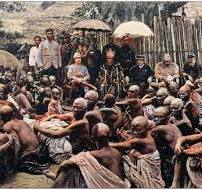
Colonial rule refers to the period when a foreign power takes control over a territory, often exploiting its resources and people. This practice was widespread from the 15th to the mid-20th century, with European powers colonizing large parts of Africa, Asia, and the Americas¹².
Colonialism had profound impacts on the colonized regions, including:
1. **Economic Exploitation**: Colonizers extracted valuable resources and wealth from the colonies, often leaving the local economies dependent and underdeveloped².
2. **Cultural Imposition**: Colonizers imposed their language, religion, and cultural practices on indigenous populations, often erasing or marginalizing local traditions².
3. **Political Control**: Colonies were governed by the colonizers, who often disregarded local governance structures and imposed their own systems¹.
4. **Social Hierarchies**: Colonial rule often established or reinforced social hierarchies, with the colonizers at the top and the local populations at the bottom¹.
Decolonization, the process of gaining independence from colonial rule, began in the 18th century and accelerated after World War II, leading to the independence of many colonies by the mid-20th century¹².
European powers used several methods to colonize Africa during the Scramble for Africa (1881-1914):
1. **Diplomatic Agreements**: European countries often signed treaties with African leaders, sometimes through coercion or deception, to gain control over territories².
2. **Military Conquest**: When diplomacy failed or was deemed unnecessary, European powers used military force to subdue African states and communities².
3. **Divide and Rule**: Europeans exploited existing rivalries and divisions among African ethnic groups to weaken resistance and establish control².
4. **Economic Pressure**: European powers used economic means, such as controlling trade routes and imposing taxes, to exert influence and control over African regions².
5. **Missionary Activities**: Christian missionaries often preceded or accompanied colonial administrations, spreading European cultural and religious values, which facilitated colonial control².
These methods allowed European powers to establish and maintain colonies across Africa, significantly impacting the continent's political, social, and economic structure
method was used extensively to colonies Africa
**Indirect rule** was a system of governance used by colonial powers, particularly the British, to control their colonies through existing local power structures¹. Here are some key aspects of indirect rule:
1. **Local Leaders**: Colonial authorities governed through traditional leaders, such as chiefs or kings, who retained some authority and were responsible for local administration¹.
2. **Cost-Effective**: This system was cheaper and required fewer European administrators, as it relied on the existing local governance structures².
3. **Cultural Preservation**: Indirect rule allowed for the preservation of local customs and traditions to some extent, as long as they did not conflict with colonial interests¹.
4. **Limited Autonomy**: While local leaders had some control over internal matters, the colonial powers retained ultimate authority, especially over external affairs, taxation, and major legal decisions¹.
This method was used extensively in British colonies like Nigeria and India, and it influenced the governance and social structures in these regions¹².
**Direct rule** is a system of governance where the central authority takes direct control over the administration of a colony, bypassing local leaders and institutions¹. Here are some key characteristics:
1. **Centralized Administration**: The colonial power directly administers the colony through its own officials and institutions, often imposing its own laws and policies¹.
2. **Limited Local Autonomy**: Local leaders and traditional governance structures are often sidelined or abolished, reducing the influence of indigenous systems¹.
3. **Uniform Policies**: The colonial power implements uniform policies across the colony, aiming for greater control and efficiency².
4. **Cultural Assimilation**: Direct rule often involves efforts to assimilate the local population into the culture of the colonizing power, including language, education, and legal systems².
An example of direct rule was the French colonial administration in West Africa, where French officials governed directly and sought to assimilate the local populations into French culture².
The **assimilation policy** was a strategy used by colonial powers to integrate indigenous populations into the colonizers' culture, often at the expense of the indigenous cultures and identities. Here are some key aspects:
1. **Cultural Erasure**: Indigenous people were encouraged or forced to adopt the language, religion, and customs of the colonizers, leading to the loss of traditional practices and identities¹.
2. **Education Systems**: Colonial governments established schools that taught the colonizers' language and values, often prohibiting the use of indigenous languages and practices².
3. **Legal and Social Integration**: Indigenous people were often required to follow the legal and social norms of the colonizers, which could include changes in dress, behavior, and social roles².
4. **Economic Changes**: Indigenous economies were often restructured to fit the needs of the colonial economy, which could involve changes in land ownership, labor practices, and trade².
The assimilation policy had long-lasting effects on indigenous communities, including the loss of cultural heritage and identity, social and economic marginalization, and intergenerational trauma¹².
.png)

.jpeg)





0 Comments: